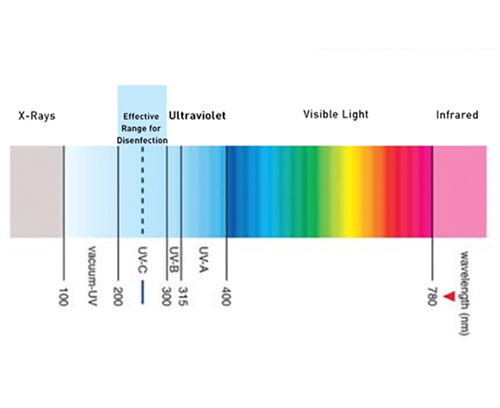

UV-C Safety — Overview
UV-C, part of the UV spectrum that includes
UV-A and UV-B, has been used since the late
1800s to kill micro-organisms. Its use
proliferated after WWII for sanitizing air in
hospitals, food processing plants, beverage
production, pharmaceutical plants and animal
labs—anywhere microbiological contamination is a concern.

UV-C Safety — Skin
Exposure to UV-A and UV-B can lead to
sunburn and skin tanning, due to their
penetration of the dermis (UV-A) and
epidermis (UV-B) outer skin layers.
However, UV-C, with its extremely poor
penetrating capability, is nearly completely
absorbed by the dead skin layer at
the skin surface.

UV-C Safety — Eyes
UV-C radiation in high doses can cause
erythema and harm superficial tissues
of the eye. Exposure may cause discomfort,
but symptoms subside within a short time
with no evidence of malignant effects.
HANDY is uniquely designed to make
unlikely any harm from direct contact.

HANDY Safety Design Emphasis
HANDY’s 4 UV-C lamps span the hand slot’s
length—2 housed in each of the top and
lower sections, providing even exposure
on all sides. Lamps are recessed from
the hand slot surface and hidden behind
louvers to prevent unintended eye exposure.
The UV-C lamps are specifically
coated to ensure consistent output and
effectiveness throughout the bulbs’ lives.
Lamps are made with glass that filters
out the 185 nm ozone-forming radiation.

Better Than Gels
• No gels or alcohol to refill–tremendous
savings in operational costs.
• Reduces use of hazardous chemicals on hands
and in environment.
• No batteries to change.
• Tablet version provides information to
employees and customers (possible ad revenue).
• No maintenance required and allows for
thousands of hours of use.
Independent testing supports HANDY and UV-C effectiveness
99.99% effective at sanitizing and germ-killing
Sanitizes air within a room via integrated fans
Also sanitizes small objects (phones, glasses, etc.)

|